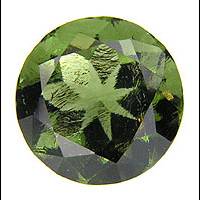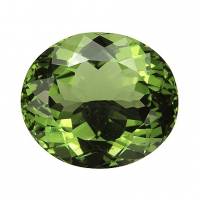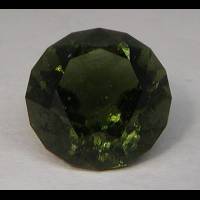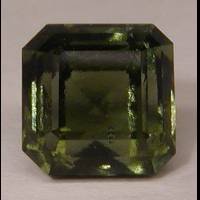Moldavite

Czech Republic
9.63 carats
© irocks.com
Moldavite is a natural glass, a variety of Tektite. Tektites are formed when terrestrial rock and soil is melted and ejected into space by meteorite impacts, and each impact produces a limited strewn field which is named. Consequently the name "moldavite" can only be used for tektites from one specific impact (in this case the Ries crater in Germany), the strewn field being mainly in the Czech Republic, together with minor neighboring areas of Germany and Austria. It is nonsense for other glasses to be marketed using variations of the name like "African Moldavite" (sic).
Moldavites are the most transparent of all the various types of tektites. They are found in many different color shades between brown and green, but normally only the ones with bottle-green hue are used for faceting. Occasionally faceted green bottle glass gets fraudulently passed off as "moldavite". True moldavite gems can be identified by their vermiform inclusions of lechatelierite (pure silica glass - melted quartz).
Moldavite Gemstones by Colour
This table shows the variety of hues this gemstone can be found in. Click on a photo for more information.
Moldavite Gemstones by Size
This table shows distribution of Moldavite gemstone sizes that are listed on this site. This can give a good indication as to the general availability of this gemstone in different sizes.
Contributed photos
Lightest:2.68 cts
Heaviest:14.01 cts
Average:8.97 cts
Total photos:8
Do you have a larger Moldavite? Why not upload a photo?
| General Information | ||||||||||||||
|---|---|---|---|---|---|---|---|---|---|---|---|---|---|---|
| A variety or type of: | Tektite | |||||||||||||
| Chemical Formula |
| |||||||||||||
| Physical Properties of Moldavite | ||||||||||||||
| Mohs Hardness | 5.5, Gemstones of the world (2001) More from other references | |||||||||||||
| Specific Gravity | 2.32 to 2.38, Gemstones of the world (2001) More from other references | |||||||||||||
| Cleavage Quality | None, Gemstones of the world (2001) | |||||||||||||
| Fracture | Conchoidal, Gemstones of the world (2001) | |||||||||||||
| Optical Properties of Moldavite | ||||||||||||||
| Refractive Index | 1.48 to 1.54, Gemstones of the world (2001) More from other references | |||||||||||||
| Optical Character | Isotropic, Gemmological Tables (2004) | |||||||||||||
| Birefringence | None, Gemstones of the world (2001) | |||||||||||||
| Pleochroism | Absent, Gemstones of the world (2001) | |||||||||||||
| Dispersion | None, Gemstones of the world (2001) | |||||||||||||
| Colour | ||||||||||||||
| Colour (General) | Bottle-green to brown-green, Gemstones of the world (2001) More from other references | |||||||||||||
| Causes of Colour | Yellowish green, Fe2+ in octahedral coordination., Pragmatic Spectroscopy For Gemologists (2011) | |||||||||||||
| Transparency | Transparent,Translucent,Opaque, Gemstones of the world (2001) More from other references | |||||||||||||
| Lustre | Vitreous, Gemstones of the world (2001) | |||||||||||||
| Fluorescence & other light emissions | ||||||||||||||
| Fluorescence (General) | None, Gemstones of the world (2001) | |||||||||||||
| Fluorescence (X-RAY) | A faint yellowish green., Gems, Sixth edition (2006) | |||||||||||||
| Crystallography of Moldavite | ||||||||||||||
| Crystal System | Amorphous, Gemstones of the world (2001) More from other references | |||||||||||||
| Geological Environment | ||||||||||||||
| Where found: | Space or impact (large meteorites), Geology of gems (2003) | |||||||||||||
| Inclusions in Moldavite | ||||||||||||||
| Gas bubbles, swirl marks - Gemmological Tables, Ulrich Henn and Claudio C. Milisenda, 2004, p 2 | ||||||||||||||
| Further Information | ||||||||||||||
| Mineral information: | Moldavite information at mindat.org | |||||||||||||
| Significant Gem Localities | ||||||||||||||
| ||||||||||||||







